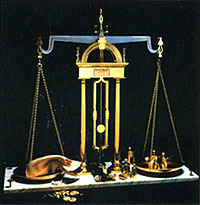Copper Scales New Heights
 A balance scale made largely of brass used to weigh gold dust and nuggets in California in the 19th Century. The scale, made in Boston by the E. Howard Company, is now in the museum in the headquarters building of the Wells Fargo Bank, San Francisco.
A balance scale made largely of brass used to weigh gold dust and nuggets in California in the 19th Century. The scale, made in Boston by the E. Howard Company, is now in the museum in the headquarters building of the Wells Fargo Bank, San Francisco.Photo courtesy Wells Fargo.
Weighing of goods and property is one of the defining phenomena of urban civilization, and copper early on played a key role in that vital governmental, commercial and industrial function. The Egyptians are believed to be the first to create scales 7,000 years ago. However, no archeologist has been able to determine the material of which those first, hieroglyphically depicted scales were made. They are likely to have been made of copper, which the Egyptians mined and smelted.
Over 4,500 years ago, the citizens of Mohenjodaro and Harappa on the Indus River in what is now Pakistan were using balance scales with copper pans (but counterweights made of cube-shaped stones). Unable to decipher the writings left by those two, great, long-abandoned trading cities (they left no Rosetta stones), the archealogists who unearthed the pans surmise they were used to weigh goods to properly assess customs duties.
Until a few decades ago, brass balance scales with counterweights made of brass were the standard of accuracy, although mechanical scales made mostly with steel were widely used for everyday weighing. Today, however, electronic scales have taken over with the wide availability of tiny, pressure-sensitive transducers that generate electric signals whose strength is proportional to the object's weight.
Balance scales are now very rare and no longer made in the USA. However, today's electronic scales require copper wire and copper in printed circuits - and in considerable amounts for the largest electronic scales, which can weigh objects as heavy as 150-ton locomotives.
Also in this Issue:
- Versatile Prepatinated Copper
- Copper Scales New Heights
- Copper Is Cooler for Cars
- Copper Contributes to Big Engines that Can
- Wiring for Today’s High-Tech Homes
- Undersea Oil Platforms Rigged with Copper
